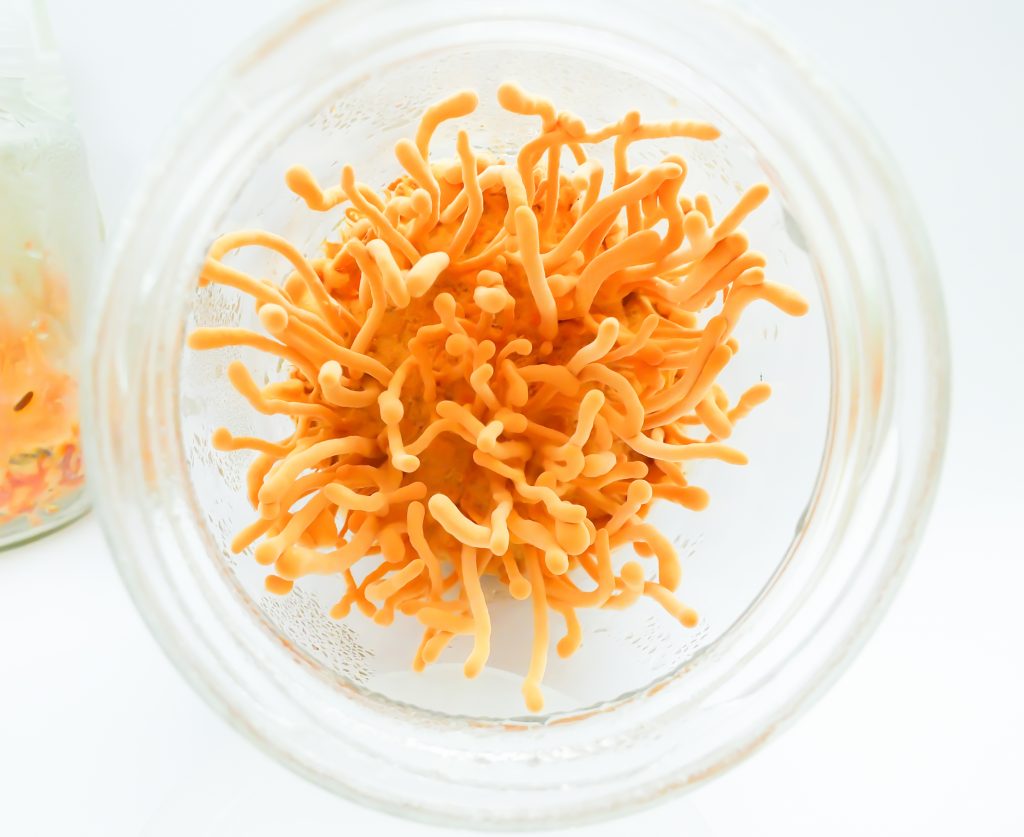 Cordyceps Fr. (Cordycipitaceae, Ascomycota) is the most diverse genus in the family Clavicipitaceae. There are currently more than 680 documented species of Cordyceps, found on six continents and in many climatic zones and habitats, and occurring parasitically or commensally with a range of hosts (Holliday et al. 2010).
Cordyceps Fr. (Cordycipitaceae, Ascomycota) is the most diverse genus in the family Clavicipitaceae. There are currently more than 680 documented species of Cordyceps, found on six continents and in many climatic zones and habitats, and occurring parasitically or commensally with a range of hosts (Holliday et al. 2010).
Cordyceps has a long history as a rare and exotic medicinal fungus. The first record about medicinal properties of Cordyceps mushroomscomes from China, in the year AD 620 at the time of the Tang Dynasty. Tibetan scholars wrote about Cordyceps through the 15 to 18 centuries, and in 1757, the earliest objective and scientifically reliable depiction of the Cordyceps mushroom was written by the author Wu-Yuluo in the Ben Cao Congxin (“New Compilation of Materia Medica”) during Qing Dynasty (Holliday et al. 2010).
The medicinal mushroom Cordyceps militaris (L.) Link, known to the Chinese as “Bei Dong Chong Xia Cao” or “Bei Chong Cao”, is a fungus which infects and grows parasitically on Lepidoptera larvae or pupae in temperate countries (Isaka et al. 2005). It is characterized by the production of orange to orange-red colored stromata that erupt from the carcass of the dead host (Mains 1958; Kobayasi 1982).
Cordyceps militaris is one of the most important and well known medicinal mushrooms frequently collected from all major continents except Antarctica. The fruiting bodies of Cordyceps militaris, which produce the active ingredients, have a rich and interesting history.
Cordyceps dietary supplements is believed to have many beneficial properties such as increased exercise performance, improved fatigue and stress resistance, improved immune function, cholesterol lowering properties, anti-tumor properties as well as anti-ageing and antioxidant properties. One of the most useful things that Cordyceps appears to do is the simple act of oxygenation. The fungus dilates the airways in the lungs, resulting in more oxygen to the blood. Thus more oxygen reaches every cell of the body, resulting in better cell and greater energy levels.
Cordyceps militaris contains many kinds of active components such as cordycepin (3’-deoxyadenosine), ergosterol, mannitol, and polysaccharides and due to its various physiological activities is now used for multiple medicinal purposes (Mizuno 1996; Song et al. 1998). To date, more than 10 nucleosides and their related components, including adenine, adenosine, cytidine, cytosine, guanine, guanosine, uracil, uridine, hypoxanthine, inosine, thymine, thymidine, 2`-deoxyuridine, 2`-deoxyadenosine, cordycepin, N6-methyladenosine, and 6-hydroxyethyl-adenosine, have been isolated and/or identified in Cordyceps (Feng et al. 2008).
The main active constituent of Cordyceps militaris is cordycepin, which was first extracted from Cordyceps militaris and then found to be present in Cordyceps sinensis (Cunningham et al. 1950).
- Cordycepin, a nucleotide analogue (Cunningham et al. 1950; Ahn et al. 2000), is considered as a nucleic acid antibiotic that might inhibit canceration of cells and thus contribute to the normalization of cancer cells as one of the constituents of gene DNA (Cunningham et al. 1950; Das et al. 2010).
- Masuda et al. (2006) reported that the cordycepin is intracellularly converted into its 5’-mono-, di- and triposphates that inhibit the activity of several enzymes in the purine biosynthetic pathway, and affects a multitude of pharmacological actions, i.e., inhibition of human glomerular mesangial cell proliferation, anti-fibrotic, anti-angiogenetic, improvement of insulin resistance and insulin secretion, anti-inflammatory and growth inhibition of Leukemia cells.
- Cordycepin itself acts as an antitumor (Penman et al. 1970; Johns and Adamson 1976; Mueller et al. 1977; Liu et al. 1997; Kodama et al. 2000), anti-proliferative (Liu et al. 1997), anti-metastatic (Liu et al. 1997; Shih et al. 2007), hypoglacemic (Yu et al. 2004; Shen and Chen 2001), anti-diabetic (Choi et al. 2004), anti-HIV (Mueller et al. 1991), insecticidal (Mao and Zhong 2006; Kim et al. 2002), and anti-bacterial (Ahn et al. 2000) compounds.
Cordycepic acid, an isomer of quinic acid, is one of the main active medicinal components. Cordycepic acid was identified as D-mannitol. Mannitol is a major bio-product with important biological activity. Mannitol is a functional polyol with notable properties. (Cunningham et al. 1950; Chatterjee et al. 1957; Liu et al. 1989).
A number of polysaccharides and other sugars have been identified from Cordyceps militaris extracts and their pharmacological activity has been reported. Research has shown these polysaccharides are affective in regulating blood sugar as well as having anti-metastatic and anti-cancer effects, hepatoprotective and antihypertensive effects (Kim et al. 2002; Yu et al. 2004).
Nucleotides (including adenosine, uridin, and guanosin) are effective components in Cordyceps militaris (Kredich and Guarino 1961; Guarino and Kredich 1963).
Ergosterol is a sterol unique to fungi and is an important precursor of Vitamin D, which has important medicinal value (Peterson 2008).
The content of crude protein in Cordyceps militaris is 28-33%. Fatty acids of Cordyceps militaris are composed of carbon, hydrogen, and oxygen and are major components of lipids, phospholipids, and glycolipids. They are saturated and unsaturated fatty acids. Generally, the contents of unsaturated fatty acids in Cordyceps militaris are higher than that of saturated fatty acids. The content of linoleic and oleic acids are higher than other fatty acids.
Many investigations show that Cordyceps militaris contains many micro- and macroelements, including K, P, Ca, Al, Mo, Na, Zn, Mg, Mn, etc.
The novel components already obtained from Cordyceps militaris already have more than 21 clinically approved beneficial effects for human health (Mizuno 1999).
Cordyceps militaris also can be used to treat conditions such as night sweating, night enuresis, asthenia after severe illness, respiratory disease, renal dysfunction, renal failure arrhythmias, and other heart disease (Mizuno 1999).
Reference: Study of Medicinal Caterpillar Fungus Cordyceps Militaris, Prof Wasser Mar2012
Anti-aging
Cordyceps militaris is widely used as a folk tonic or invigorant for longevity in China. This study showed that C.Militaris polysaccharides protected mitochondria by scavenging reactive oxygen species, and increasing the activities of the antioxidases. Therefore, C.Militaris polysaccharides have antioxidant and anti-aging pharmaceutical values hence useful for the treatment of mitochondria-related metabolic disorders and delaying the aging process.
Reference: Protective Effects on Mitochondria and Anti-Aging Activity of Polysaccharides from Cultivated Fruiting Bodies of Cordyceps militaris: The American Journal of Chinese Medicine, Vol. 38, No. 6, 1093–1106, 2010
Anti-oxidant
Polyphenolics and polysaccharides present in CME and CSE appear to be major contributors of antioxidant phytochemicals. This observation may partly be responsible for the biological effects of CME and CSE. Therefore, additional consumption of CME and CSE may increase the levels of phytochemicals and enhance therapeutic effects in human diseases related tooxidative stress. The protective effects of CME and CSE against oxidative damage of biomolecules are a result of their free radical scavenging abilities.
Reference: Comparison of Protective Effects between Cultured Cordyceps militaris and natural cordyceps sinensis against oxidative damage: J Agric Food Chem. 2006 Apr 19; 54(8):3132-8.
Cancer
The regulation of tumor cell growth and the induction of cell death are the 2 major ways to inhibit tumor growth. The study showed that C.militaris act as an effective anti-proliferative agent by inducing G2/M cell cycle arrest in colon cancer cells.
Reference: Cordyceps militaris Grown on Germinated Soybean Induces G2/M Cell Cycle Arrest through Downregulation of Cyclin B1 and Cdc25c in Human Colon Cancer HT-29 Cells: Evidence-Based Complementary and Alternative Medicine, Volume 2012, Article ID 249217
Diabetes
Lipid metabolic disorder has been found to play an important role in type 2 diabetes. The effects of 3-deoxyadenosine (Cordycepin), a compound from Cordyceps militaris were investigated and its main function may be improved insulin resistance, especially in the skeletal muscles. Thus, Cordycepin has the potential to be developed as a drug for the treatment of lipid metabolic disorder.
Reference: Improvement on Lipid Metabolic Disorder by 3-Deoxyadenosine in High-Fat-Diet-Induced Fatty Mice: The American Journal of Chinese Medicine, Vol. 38, No. 6, 1065–1075, 2010
Sexual function
Cordyceps species have been traditionally used for the enhancement of sexual function. This study showed that serum testosterone was increased by supplementation with C.Militaris suggesting that the sexual hormone might be responsible for the increased semen production and sperm quality in SD rats.
Reference: Effect of Cordyceps Militaris Supplementation on Sperm Production, Sperm Motility and Hormones in Sprague-Dawley Rats: The American Journal of Chinese Medicine, Vol. 36, No. 5, 849–859, 2008
Anndy Lian
